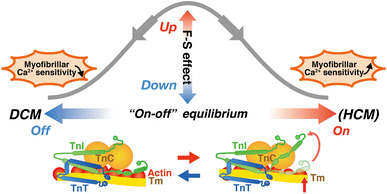Fig. 6.

Relationship between the “on–off” equilibrium of the thin filament state and the magnitude of length-dependent activation. Length-dependent activation [noted as “F–S (Frank–Starling) effect”] becomes less pronounced when the equilibrium is shifted toward either the “on” state or the “off” state, but via different mechanisms. Namely, on the one hand, when the equilibrium is shifted toward the “on” state (as presumably in some mutated HCM hearts), the length dependence becomes attenuated, coupled presumably with a decrease in the number of recruitable (+ATP) cross-bridges (cf. [5–7]). On the other hand, when the equilibrium is shifted toward the “off” state (as in ΔK210 hearts; [8]), the length dependence becomes attenuated, via reduction in thin filament cooperative activation and the ensuing suppression of myosin attachment to actin upon lattice spacing reduction
